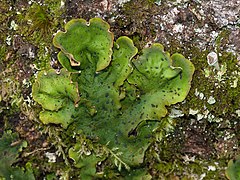Peltigerales: Difference between revisions
→References: Add authority control taxa. |
m made a link |
||
| Line 26: | Line 26: | ||
'''Peltigerales''' is an [[order (biology)|order]] of [[lichen]]-forming [[fungus|fungi]] belonging to the [[class (biology)|class]] [[Lecanoromycetes]] in the [[division (biology)|division]] [[Ascomycota]]. The taxonomy of the group has seen numerous changes; it was formerly often treated as a suborder of the order [[Lecanorales]]. It currently contains two suborders, seven [[family (biology)|families]] and about 45 [[genus|genera]] such as ''[[Lobaria]]'' and ''[[Peltigera]]''. |
'''Peltigerales''' is an [[order (biology)|order]] of [[lichen]]-forming [[fungus|fungi]] belonging to the [[class (biology)|class]] [[Lecanoromycetes]] in the [[division (biology)|division]] [[Ascomycota]]. The taxonomy of the group has seen numerous changes; it was formerly often treated as a suborder of the order [[Lecanorales]]. It currently contains two suborders, seven [[family (biology)|families]] and about 45 [[genus|genera]] such as ''[[Lobaria]]'' and ''[[Peltigera]]''. |
||
The fungi form lichens in a [[symbiosis|symbiotic]] relationship with one or two [[photosynthesis|photosynthetic]] partners which may be a [[cyanobacterium]] such as ''[[Nostoc]]'' or a [[green alga]] such as ''[[Coccomyxa]]''. The majority of species contain just a cyanobacterium, a smaller number have both a cyanobacterium and a green alga while only a few species have just a green alga. The [[thallus]] of the lichen may be foliose (leafy), subfruticose (somewhat shrubby) or granular-squamulose (scaly). The thallus attaches to a surface by means of small root-like |
The fungi form lichens in a [[symbiosis|symbiotic]] relationship with one or two [[photosynthesis|photosynthetic]] partners which may be a [[cyanobacterium]] such as ''[[Nostoc]]'' or a [[green alga]] such as ''[[Coccomyxa]]''. The majority of species contain just a cyanobacterium, a smaller number have both a cyanobacterium and a green alga while only a few species have just a green alga. The [[thallus]] of the lichen may be foliose (leafy), subfruticose (somewhat shrubby) or granular-squamulose (scaly). The thallus attaches to a surface by means of small root-like [[rhizine]]s. In some species, the thallus may vary in appearance depending on whether it contains a cyanobacterium or a green alga. Sometimes these different morphs of a single fungus were formerly thought to be separate species. |
||
The lichens occur worldwide, growing on [[bark]], [[moss]], soil or rocks in humid [[woodland]]. The greatest diversity occurs in the Northern Hemisphere although the family [[Lobariaceae]] is most diverse in the Southern Hemisphere. |
The lichens occur worldwide, growing on [[bark]], [[moss]], soil or rocks in humid [[woodland]]. The greatest diversity occurs in the Northern Hemisphere although the family [[Lobariaceae]] is most diverse in the Southern Hemisphere. |
||
Revision as of 18:40, 10 April 2017
| Peltigerales | |
|---|---|

| |
| Peltigera aphthosa | |
| Scientific classification | |
| Kingdom: | |
| Division: | |
| Class: | |
| Subclass: | |
| Order: | Peltigerales |
| Suborders and families | |
|
Suborder Collematineae Suborder Peltigerineae
| |
Peltigerales is an order of lichen-forming fungi belonging to the class Lecanoromycetes in the division Ascomycota. The taxonomy of the group has seen numerous changes; it was formerly often treated as a suborder of the order Lecanorales. It currently contains two suborders, seven families and about 45 genera such as Lobaria and Peltigera.
The fungi form lichens in a symbiotic relationship with one or two photosynthetic partners which may be a cyanobacterium such as Nostoc or a green alga such as Coccomyxa. The majority of species contain just a cyanobacterium, a smaller number have both a cyanobacterium and a green alga while only a few species have just a green alga. The thallus of the lichen may be foliose (leafy), subfruticose (somewhat shrubby) or granular-squamulose (scaly). The thallus attaches to a surface by means of small root-like rhizines. In some species, the thallus may vary in appearance depending on whether it contains a cyanobacterium or a green alga. Sometimes these different morphs of a single fungus were formerly thought to be separate species.
The lichens occur worldwide, growing on bark, moss, soil or rocks in humid woodland. The greatest diversity occurs in the Northern Hemisphere although the family Lobariaceae is most diverse in the Southern Hemisphere.
Members of the suborder Peltigerineae produce a wide range of secondary compounds, some of which are useful to humans in medicine and dyeing. Former uses include using Peltigera canina (dog lichen) as a remedy for the bite of a mad dog and Lobaria pulmonaria (tree lungwort) as a remedy for lung diseases because of its supposed resemblance to lung tissue.
References
- Gilbert, Oliver (2000) Lichens, HarperCollins, London.
- Hibbett, David S.; Binder, M; Bischoff, JF; Blackwell, M; Cannon, PF; Eriksson, OE; Huhndorf, S; James, T; et al. (2007). "A higher-level phylogenetic classification of the Fungi" (PDF). Mycological Research. 111 (Pt 5): 509–547. doi:10.1016/j.mycres.2007.03.004. PMID 17572334.
- Lumbsch, H. T.; Huhndorf, S.M. (2007). "Outline of Ascomycota – 2007" (PDF). Myconet. 13: 1–58.
- Miadlikowska, Jolanta; Lutzoni, François (2004). "Phylogenetic classification of peltigeralean fungi (Peltigerales, Ascomycota) based on ribosomal RNA small and large subunits". American Journal of Botany. 91 (3): 449–464. doi:10.3732/ajb.91.3.449. PMID 21653401.
- Miadlikowska, Jolanta; Kauff, F; Hofstetter, V; Fraker, E; Grube, M; Hafellner, J; Reeb, V; Hodkinson, BP; et al. (2006). "New insights into classification and evolution of the Lecanoromycetes (Pezizomycotina, Ascomycota) from phylogenetic analyses of three ribosomal RNA- and two protein-coding genes" (PDF). Mycologia. 98 (6): 1088–1103. doi:10.3852/mycologia.98.6.1088. PMID 17486983.
